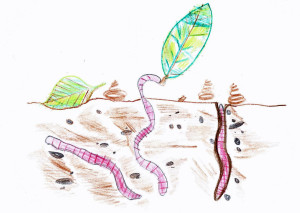
Earthworms, as their name suggests, live within the earth in a hidden world but where they perform an essential service by not only turning over, aerating and loosening soil, but also by recycling dead things! Autumn is a great time to pull on your welly boots, get outdoors and discover these amazing but often overlooked soil engineers at work.
Earthworms are segmented worms (phylum Annelida): they breathe through mucus covered skin, do not like sunlight or drying out and have eight small bristles called setae, in paired rows on each segment along their body. These help the earthworm move – its movement is similar to a slinky toy.
There are 27 species of earthworm in the UK and these are divided into three groups based on their feeding and burrowing habits.
Some earthworms live in compost or on the surface of the soil in leaf litter and do not make burrows. I like to call these the ‘composters’. Some live in permanent vertical burrows deep down in the soil (these are the ‘miners’), where others are content with the middle ground (top soil) and make complex networks of horizontal burrows as they feed on the soil (I call these the ‘tremors’).
It’s the ‘miners’ that visit the soil surface, especially on mild wet nights, where they drag dead leaves down into their burrows. Safely underground they eat and breakdown the decaying plant matter and excrete the waste called castings above ground. These casts are rich in recycled organic nutrients (humus) and improve soil fertility. Look for ‘middens’ – piles of worm casts around the entrance of a burrow.
These earthworms are darkly coloured at the pointy head end (red or brown) and have paler rounded tails. To be sure which end is which simply watch it burrow back into the soil – the pointy end will disappear first! They can move forwards and backwards in their burrows and have a surprisingly strong grip – which you will have noticed if you’ve ever watched a robin struggling for its meal.
The famous naturalist Charles Darwin spent 40 years studying earthworms and referred to them as ‘nature’s ploughs’ because of how they mix soil and organic matter together and create passages for air and water to travel through the soil. They really are a gardener’s best friend and perform a vital recycling service which we shouldn’t take for granted.
Ideas for investigations:
A worm in the hand: Put an earthworm on a piece of paper and listen to the scratchy sound which is its bristles rubbing against the paper at it wiggles. Then put the earthworm on your hand – can you feel the bristles? Remember to be respectful – it is a living creature.
Worm charming: Vibrating the soil can attract earthworms to the surface – it’s been suggested that the vibrations are similar to digging moles who prey on earthworms. Try different techniques – from banging a wooden stake into the ground to playing music! Birds are often seen tapping the earth with their feet to generate vibrations to catch a worm.
It’s raining, it’s pouring: Water a dry patch of grass and watch to see if worms come up. Note: worms do not drown in water.
Worm plugs: Look for small piles of rotting leaves pulled together on the soil surface. Earthworms block the mouth of their burrows to help stop the tunnels being flooded by rainwater. Carefully lift to find its burrow entrance.
Citizen science: Take part in OPALS Soil and Earthworm Survey and help improve scientist’s knowledge about earthworms and soils they live in. Go to www.opalexplorenature.org for instructions and an excellent earthworm identification guide.
Create a worm farm: Put alternate layers of fine sand and soil in a large jar. Add a few worms and some leaves for them to feed on. Wrap and tie brown paper around the jar to keep the light out. After two days remove the paper to observe how the worms have mixed up the layers.
Buy a wormery: A tiered system of composting with earthworms is an excellent way of recycling garden and household green waste. The resulting compost is excellent for potting and a good fertiliser in the garden. Compost worms (Brandling worm) are red in colour and stripy – often called ‘tiger worms’!
Glossary:
Composters – Compost and Epigeic earthworms.
Tremors – Endogenic earthworms
Miners – Anecic earthworms
